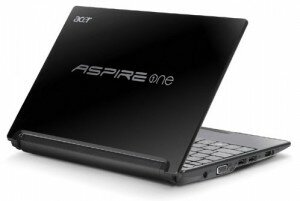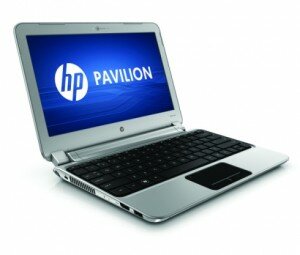AMD’s Fusion processors are now widely available in a number of laptops. The new APU combines the power of a netbook processor with Radeon graphics, creating a well-balanced product that offers better all-around performance than Intel’s Atom processors and their anemic IGP. Indeed, the performance gap is sometimes massive, particularly in games and HD video playback.
There are quite a few AMD Fusion laptops available, but as is always the case, some excel where others fail. In this post I’m going to roundup the three best AMD fuson laptops currently available. These inexpensive computers are great because of their affordability, portability or both.
Acer, one of the most popular netbook manufactures, was naturally quick to jump on the Fusion bandwagon. They’re already offering a few models with AMD Fusion processors, but the Acer Aspire One AO522 is the least expensive of them and, I think, the best.
This particular Acer Aspire One model doesn’t do anything revolutionary. The chassis, for example, isn’t much different from what was found on past Acer Aspire One netbooks, and some of the specifications- such as the 1GB of RAM and 250GB hard drive – are instantly recognizable. However, the does offer a 10.1″ display with a resoultion of 1280×720, which is a bit higher than normal.
AMD’s Fusion processor is the real star of this show. Because of its graphics firepower, the Acer Aspire One AO522 is notably quicker than older netbooks saddled with Intel’s Atom and its antique IGP. While the C-5o processor in this Fusion laptop is clocked at just 1 GHz, it is a dual core part, and the Bobcat architecture used by the AMD Fusion processors is quicker per-clock than Intel’s Atom.
Overall, the is not only one of the best Fusion laptops currently available but also one of the best netbooks on the market right now. The low price of just $329.99 is just icing on an already appetizing cake.
HP has been trying for some time to use AMD processors in inexpensive put powerful laptops, but so far hasn’t had much luck. The previous HP Pavilion dv2, for example, was a fine piece of kit. But it was ultimately limited by the fact that AMD’s ultraportable processor offerings were, at the time, power hungry.
Now that Fusion has launched, however, HP finally has some nice material to work with. The result is a sleek, svelte netbook / ultraportable with an 11.6″ display and a dual-core E-350 Fusion processor. HP has been trickling the design of its HP Envy laptops down to its less expensive models, and the is one of the latest beneficiaries. It is an elegant, smooth laptop that gives up glossy colors and chrome trim for flat silvers and black.
The is as practical as it looks. It packs AMD’s most powerful Fusion processor, the E-350, which feature two cores clocked at 1.6 GHz. This is supported by three gigabytes of RAM, a 320GB hard drive, and a display resolution of 1366×768. The dm1z also benefits from a spacious keyboard and large touchpad.
As you might have guessed from the specifications, the HP Pavilion dm1z is more upscale than your typical netbook PC. The price, as a result, is usually around $600. That may seem a bit high, but the quality of the dm1z justifies the price.
The Atom processor started a revolution of small laptops at inexpensive prices, but it never trickled over to larger PCs. The reason for this was quite simple; Intel didn’t want Atom to compete with its mainstream Core branded processors, so it didn’t let manufacturers use Atom processors in laptops with a display size larger than 12.1 inches.
AMD has no such qualms, however, so we’re now seeing AMD Fusion laptops enter the market with low-power processors but large 15.6″ displays. One of these laptops is the, which is powered by a single-core AMD E-240 clocked at 1.5 GHz. It also has two gigabytes of RAM and a 320GB hard drive.
Although it packs a tiny APU, the uses the same chassis as inexpensive 15.6″ Toshiba laptops with Intel Core 2 Duo and Core i3 processors. This has two benefits for consumers. First, it means that the chassis of this laptop, although bare-bones, is incredibly robust for the price. And second, it means that the cooling design of this chassis is far more than the APU calls for. The laptop is virtually silent as a result.
While the size of the Toshiba Satellite C655D-S5134 makes it less portable than the other options here, it still offers between 4 and 5 hours of battery life – and since it’s so big, the keyboard is extremely spacious and easy to use.





You must log in to post a comment.
{ 2 trackbacks }